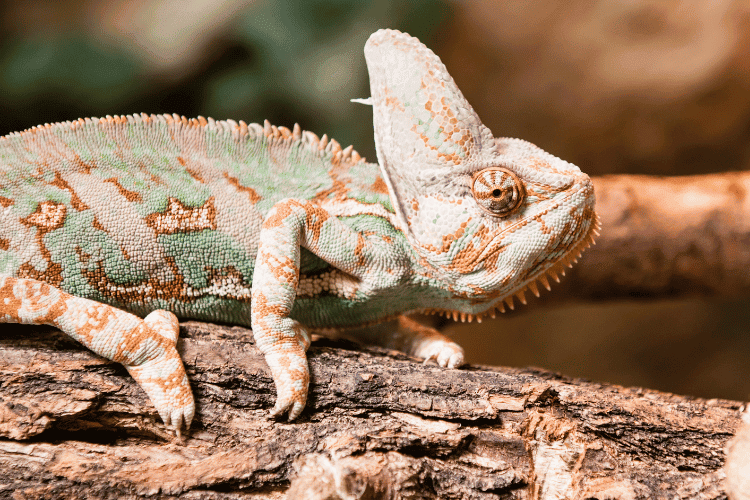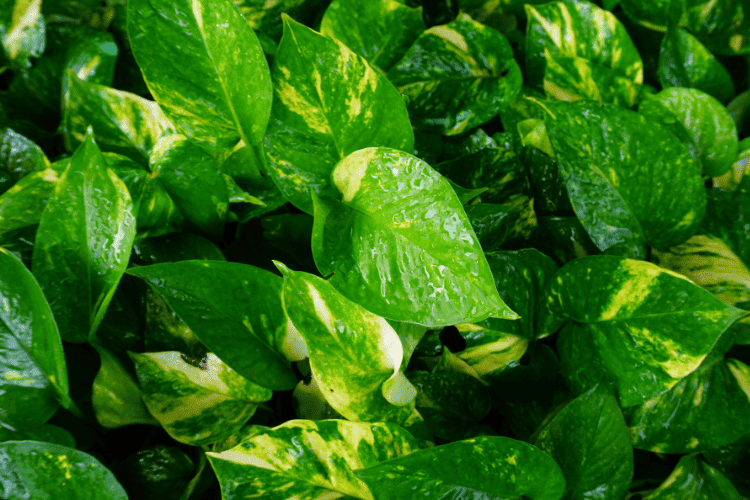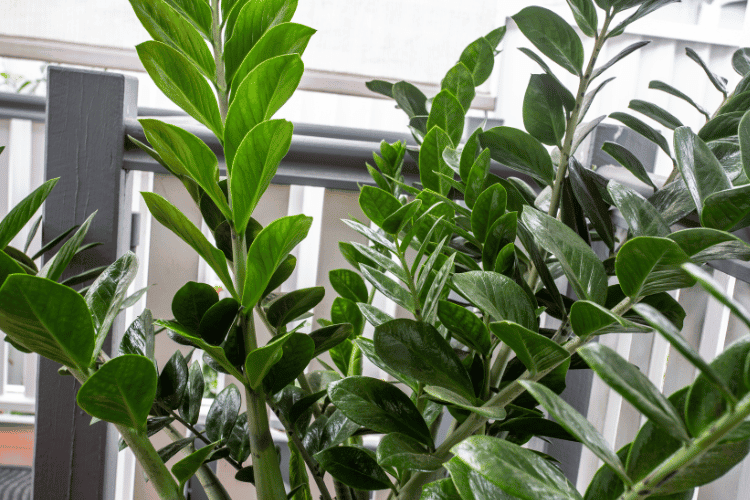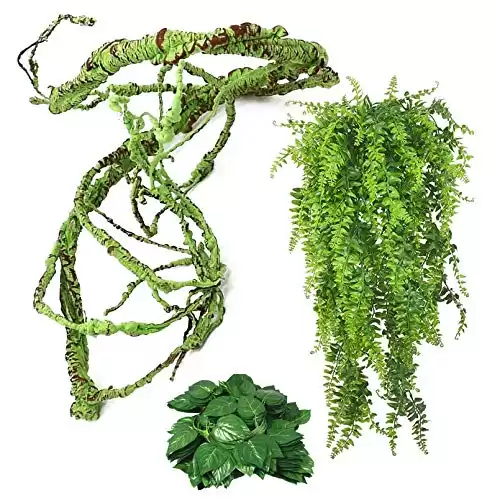Plants are essential for veiled chameleons. They provide them with a safe and comfortable habitat, food, humidity, and enrichment.
When choosing plants for your chameleon’s enclosure, be sure to select a variety of different sizes, shapes, and textures to provide your chameleon with a stimulating environment.
This article has the best list of safe plants for veiled chameleons, in addition to a full guide on how to choose the right plants for your pet lizard.
Why Are Plants Important for Veiled Chameleons?

Veiled chameleons are arboreal reptiles, meaning they spend most of their time in trees. In the wild, they inhabit rainforests and other humid environments, where they are surrounded by a variety of plants. Plants are essential for veiled chameleons in a number of ways, including:
- Habitat: Plants provide veiled chameleons with a safe and comfortable habitat. They can hide from predators, bask in the sun, and sleep in the branches and leaves of plants.
- Food: Veiled chameleons are omnivores, but their diet consists primarily of insects. Many insects are attracted to plants, so having a variety of plants in your chameleon’s enclosure can provide it with a steady supply of food.
- Humidity: Plants help to increase the humidity in a chameleon’s enclosure. Chameleons need a high-humidity environment to stay healthy, and plants can help to provide this by releasing water vapor into the air.
- Enrichment: Plants provide veiled chameleons with physical and mental enrichment. They can climb, explore, and hide in the plants, which helps to keep them active and engaged.
How to Choose Safe Plants for Veiled Chameleons
When choosing plants for your veiled chameleon’s enclosure, it is important to select plants that are safe for your chameleon to eat and interact with.
Some plants are toxic to chameleons, and others can have sharp thorns or other features that could injure your Here are some tips for choosing safe plants for veiled chameleons:
- Do your research. Before you buy any plants for your chameleon’s enclosure, be sure to research them to make sure they are safe. There are many resources available online and in libraries that can help you identify safe plants for chameleons.
Also, look for plants that do not require bright light, as chameleons are not big fans of that. Green leaves do not always mean that the plants need direct sunlight. In fact, shade plants are a much better option, and they favor indirect light.
- Avoid plants with toxic properties. Some common plants that are toxic to chameleons include oleander, ivy, and philodendron. Be sure to avoid these plants and any other plants that are known to be toxic to chameleons.
- Choose plants with smooth leaves. Chameleons have delicate skin, so it is important to choose plants with smooth leaves that will not irritate their skin. Avoid plants with sharp thorns or other features that could injure your chameleon.
- Select a variety of plants. Chameleons enjoy having a variety of plants to climb and explore. Choose plants of different sizes and shapes to create a stimulating environment for your chameleon.
The 10 Safest Plants for Veiled Chameleons
Looking for the safest plants to add to your veiled chameleon’s enclosure? Look no further! Here’s a list of the top 10 safest plants for veiled chameleons. They are also the most popular, so it wouldn’t be too difficult to find them.
1. Pothos (Epipremnum aureum)

This popular houseplant is also a great choice for chameleons. It’s non-toxic, easy to care for, and can be grown in a variety of forms, from vines to bushes. Plus, it’s relatively inexpensive, so you can stock up without breaking the bank.
Pothos plants are so good at filtering air that they’re often used in NASA clean air studies. So, not only will your chameleon have a safe and comfortable place to climb and explore, but you’ll also be breathing cleaner air!
2. Ficus (Ficus spp.)
Ficus plants are another great option for chameleons. They’re available in a variety of sizes and shapes, so you can find the perfect one for your chameleon’s enclosure. Ficus plants are also relatively easy to care for, and they can provide your chameleon with plenty of hiding places.
Ficus plants are home to a variety of insect species, so your chameleon may be able to find a snack or two while exploring its new plant friends.
3. Hibiscus (Hibiscus spp.)
Hibiscus plants are a beautiful and colorful addition to any chameleon enclosure. They’re also relatively easy to care for, and they can provide your chameleon with plenty of flowers and leaves to nibble on.
Hibiscus flowers are edible and can be used to make tea. This feels like you and your chameleon can enjoy a cup of hibiscus tea together!
4. Grape Ivy (Cissus rhombifolia)
Grape ivy is a fast-growing vine that can quickly provide your chameleon with plenty of climbing room. It’s also non-toxic and easy to care for. Grape ivy is native to tropical regions, so it’s the perfect plant to help your chameleon feel at home in its enclosure.
5. Boston Fern (Nephrolepis exaltata)
Boston ferns are a beautiful and lush addition to any chameleon enclosure. They’re also relatively easy to care for, and they can help to increase the humidity in your chameleon’s enclosure.
Boston ferns are known for their air-purifying properties, so they can help to keep your chameleon’s enclosure healthy and clean.
6. Spider Plant (Chlorophytum comosum)
Spider plants are easy to care for and produce lots of baby plants, which can be used to create a lush and leafy enclosure for your chameleon. Spider plants are also known to remove toxins from the air. The overall air quality in your chameleon’s enclosure would certainly benefit from that.
7. Snake Plant (Sansevieria trifasciata)
Snake plants are very hardy and can tolerate low light conditions, making them a good choice for chameleon enclosures that don’t receive a lot of natural light. Snake plants are also known to release oxygen at night, which can help to improve the air quality in your chameleon’s enclosure during the hours when it’s sleeping.
8. Air Plant (Tillandsia spp.)
Air plants are unique in that they don’t need to be planted in soil. They can be attached to branches, driftwood, or other objects in your chameleon’s enclosure, which adds visual interest and provides your chameleon with additional climbing surfaces. Air plants are also known to absorb pollutants from the air.
9. Philodendron (Philodendron spp.)
Philodendron plants come in a variety of sizes and shapes, so you can find the perfect one for your chameleon’s enclosure. They’re also relatively easy to care for and can provide your chameleon with plenty of hiding places. Philodendron plants are also known to release oxygen at night.
10. ZZ Plant (Zamioculcas zamiifolia)
ZZ plants are very hardy and can tolerate low light conditions and infrequent watering, making them a good choice for busy chameleon owners. They are also known to remove toxins from the air, so they can help to keep your chameleon’s enclosure safe and healthy.

How to Identify and Avoid Toxic Plants
Veiled chameleons are curious creatures that love to explore their surroundings. This can sometimes lead them to eat plants that are toxic, which can cause serious health problems or even death.
It is important to be able to identify and avoid toxic plants when choosing plants for your veiled chameleon’s enclosure.
- Learn the common names of toxic plants. You can learn the common names of some of the most common toxic plants, such as oleander, ivy, and philodendron. This will help you to avoid these plants when you are shopping for plants for your chameleon’s enclosure.
- Look for common signs of toxicity. Some common signs that a plant may be toxic to chameleons include:
- A milky or sap-like substance
- Sharp thorns or spines
- A strong, unpleasant odor
- Unusual leaf shapes or colors
- Be wary of plants that are toxic to humans or other animals. Many plants that are toxic to humans and other animals are also toxic to chameleons. It is best to err on the side of caution and avoid these plants altogether.
- If you are unsure whether a plant is safe, it is best to avoid it. There are many safe plants available, so there is no need to risk your chameleon’s health by using a plant that you are unsure about.
- Consult with a veterinarian or experienced chameleon breeder. If you are unsure whether a plant is safe for your veiled chameleon, consult with a veterinarian or experienced chameleon breeder. They can help you to identify safe plants and avoid toxic ones.
- Keep a list of safe plants on hand. It is helpful to keep a list of safe plants on hand so that you can easily reference it when choosing plants for your chameleon’s enclosure. You can find lists of safe plants online and in books about chameleon care.
- Be aware of the different types of toxicity. Some plants are toxic if ingested, while others are toxic if touched or rubbed against. It is important to be aware of the different types of toxicity so that you can take the appropriate precautions.
To Sum Up
When you are buying plants for your chameleon’s enclosure, be sure to buy them from a reputable source. This will help to ensure that the plants are healthy and free of pests and diseases.
Before introducing any new plants to your chameleon’s enclosure, be sure to quarantine them for at least two weeks. This will help to prevent the introduction of pests and diseases into your chameleon’s enclosure.
Finally, inspect your chameleon’s plants regularly for pests, diseases, and damage. If you find any problems, remove the affected plant from the enclosure immediately.
By following these tips, you can choose safe and healthy plants for your veiled chameleon’s enclosure. Your chameleon will appreciate the variety and enrichment that plants provide, and you will have the peace of mind knowing that your pet is safe.


